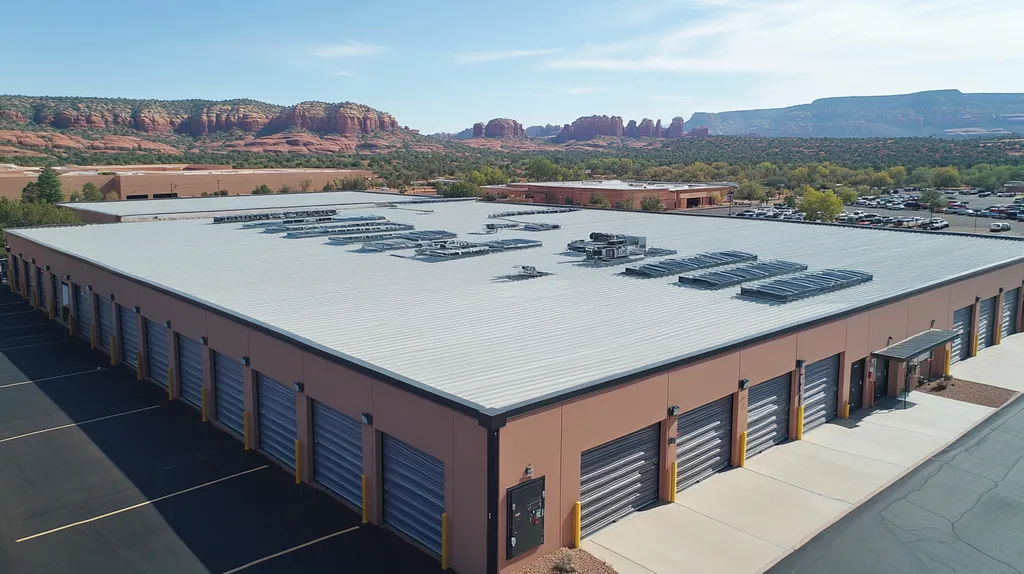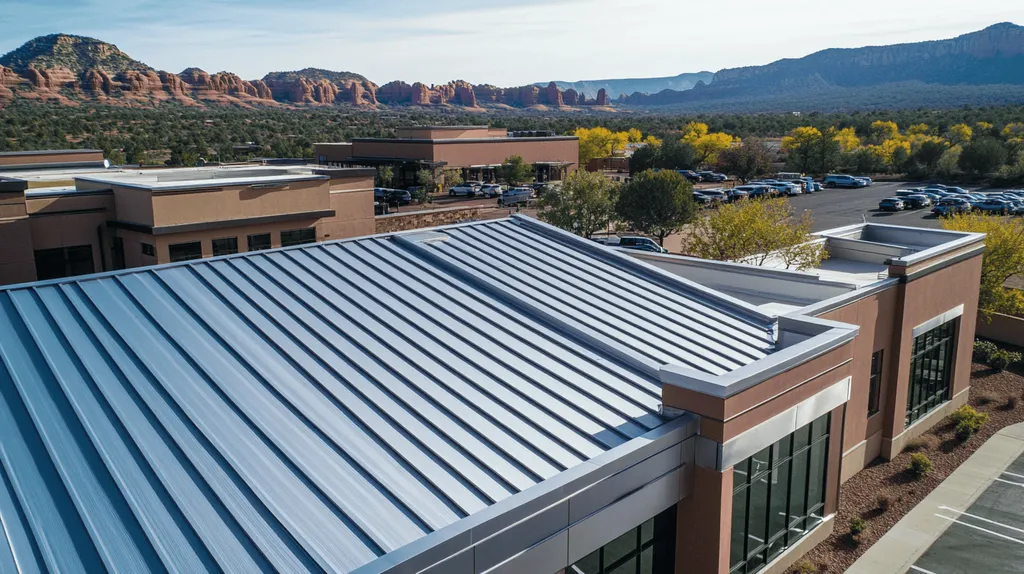Every year, commercial roofing projects generate over 11 million tons of waste in the United States, with up to 95% of materials ending up in landfills unnecessarily. This mounting crisis creates both environmental damage and rising disposal costs for property owners.
However, recent advances in recycling technology and growing contractor participation have made material recovery increasingly viable. Modern recycling programs can now process everything from metal components to membrane systems.
This comprehensive guide provides property professionals with actionable steps for implementing successful roofing material recycling programs while managing performance, costs, compliance, and operational factors.
SECTION 1: PERFORMANCE FACTORS
In an era where sustainability is critical, recycling materials from old commercial roofs has never been more important. The United States generates approximately 11 million tons of roofing waste each year, contributing significantly to environmental degradation. By recycling, property owners can conserve resources and alleviate disposal costs. This section will discuss the durability of roofing materials, the feasibility of recycling roof membranes and insulation, and how roofing system design affects the recycling process.
Material Durability and End-of-Life Characteristics
The durability and composition of roofing materials are crucial when considering their recyclability. Some materials, like metal and certain asphalt types, are designed to withstand weather and wear over time. When it’s time for replacement, knowing these traits helps property owners determine which components are suitable for reclamation.
For example, while aged TPO or PVC membranes may show decreased performance, they can still be valuable for recycling. Asphalt shingles, often seen as waste, can be repurposed into new roofing products or even road asphalt. Assessing materials based on their end-of-life potential is essential for successful recycling.
Thus, property managers should focus on selecting durable materials that are conducive to recycling. This proactive strategy not only reduces waste but also supports broader environmental goals.
Key Action Items
Roof Membrane and Insulation Recycling Feasibility
The ability to recycle roof membranes and insulation is a pressing issue for property managers. Modern roofing membranes, such as TPO and PVC, are built for durability and have potential for recycling. Nevertheless, contamination from other materials can complicate these efforts.
Insulation materials like polyisocyanurate can pose additional challenges. While some types can be reclaimed, others may be rejected by recyclers due to harmful chemicals or contamination risks. Property owners should look into local recycling facilities and understand their specific requirements.
Working with knowledgeable roofing contractors can help identify which membranes and insulation are suitable for recycling in specific regions. Ultimately, maximizing recycling potential hinges on thoughtful planning during both installation and demolition, fostering a sustainable future.
Key Action Items
Impact of Roofing System Design on Recycling Ease
The design of a roofing system can greatly affect how easily it can be recycled. Complex systems with multiple layers and integrated components may complicate disassembly, making recycling more difficult. In contrast, simpler roofs tend to be easier to dismantle and recover materials.
For instance, single-ply membrane roofs can often be separated from insulation with relative ease, while built-up roofs featuring multiple layers may hinder recycling efforts. Thoughtful design should prioritize the future recovery of materials.
Additionally, innovative roofing systems are increasingly being created with recyclability in mind. Property owners should collaborate with roofing professionals who embrace sustainable design principles that simplify material recovery and promote a circular economy.
Key Action Items
SECTION 2: FINANCIAL CONSIDERATIONS
As property owners and facility managers navigate the complexities of disposing old commercial roofing materials, the stakes are higher than ever. With landfills nearing capacity and disposal costs increasing, turning to recycling emerges as a savvy financial decision. This section delves into the financial implications of recycling compared to traditional disposal methods, highlighting cost comparisons, potential savings from reduced landfill fees, and the effects of contractor recycling participation on budgeting.
Cost Comparison: Recycling vs. Traditional Disposal
The initial task for property managers is to compare the costs associated with recycling versus traditional disposal. Often, recycling proves to be more budget-friendly, particularly when considering labor and the degradation of materials over time. Many recycling facilities not only maintain competitive rates, but they may also offer rebates for specific materials, making the option more appealing.
For instance, the costs incurred for landfill disposal can skyrocket, sometimes reaching thousands of dollars depending on the volume and local regulations. On the other hand, recycling can cut these expenses by utilizing specialized contractors who are dedicated to repurposing materials. It’s advisable for property managers to acquire quotes from both traditional waste disposal companies and recycling services to make an informed financial decision.
A thorough cost analysis often reveals that recycling is not just a sustainable choice but also aligns with fiscal prudence. By embracing recycling, facilities can lower their operational costs while supporting eco-friendly practices.
Key Action Items
Potential Cost Savings from Reduced Landfill Fees
Shifting towards recycling can lead to significant cost savings by keeping materials out of crowded landfills. Many municipalities charge mounting fees for landfill usage, which continue to rise as waste management becomes a pressing concern. By opting for recycling, property professionals can greatly reduce these fees and contribute positively to the environment.
Consider that disposing of just one ton of roofing materials can cost hundreds of dollars in landfill fees. By recycling, facility managers not only achieve immediate savings but also embrace sustainability, which may earn them recognition and incentives from local governments.
Some states even provide tax benefits or grants to support businesses that engage in eco-friendly practices, including recycling efforts. This dual opportunity allows property owners to cut costs while enhancing their green credentials.
Key Action Items
Budget Implications of Contractor Recycling Participation
Hiring contractors who prioritize recycling can have a significant positive impact on budgeting for property managers. Selecting roofing professionals experienced in recycling practices often leads to long-term savings and an efficient roofing process. Their expertise can help ensure that recyclable materials are correctly processed, reducing delays and labor costs during roof removal and replacement.
Moreover, contractors who are committed to sustainability can enhance the market appeal of a property, making it more attractive to eco-conscious tenants. Forming partnerships with recycling companies can also provide ongoing support and transparency in material management, reinforcing a framework for future roofing projects.
By incorporating recycling practices into the budgeting process, facility managers can ensure that eco-friendly initiatives align with their organization’s financial goals.
Key Action Items
SECTION 3: COMPLIANCE REQUIREMENTS
Understanding compliance requirements is crucial for property professionals looking to recycle materials from old commercial roofs. Adhering to local, state, and federal regulations is not just a legal obligation but a vital component of sustainable roofing practices. Failure to meet these guidelines can incur hefty fines and contribute to environmental harm. This section explores the key compliance considerations that every property owner should be aware of to ensure effective and safe recycling.
Local, State, and Federal Recycling Regulations
Every property owner must be aware of the specific recycling regulations in their jurisdiction. Local laws often define how roofing materials should be processed, guiding requirements for sorting and transporting waste. In contrast, state regulations set forth broader recycling goals and practices applicable to specific materials.
Federal guidelines, particularly those from the Environmental Protection Agency (EPA), play a pivotal role in shaping these regulations. They align with national efforts to reduce landfill waste while promoting recycling. It’s essential for property professionals to grasp these regulations to avoid legal repercussions and enhance their sustainability initiatives.
For instance, several states mandate recycling for certain roofing materials, stipulating that a percentage of waste must be diverted from landfills. By ensuring compliance, property owners not only meet their legal responsibilities but also strengthen their image as environmentally conscious businesses. Regular training on regulatory updates is recommended to keep facilities managers informed and prepared.
Key Action Items
Documentation and Reporting for Recycled Materials
Accurate documentation and reporting are essential components of the recycling process for roofing materials. Property owners must keep detailed records of all materials sent for recycling, fulfilling both regulatory obligations and providing insight into recycling efficiencies.
Many jurisdictions require the submission of recycling reports to local authorities, detailing the quantities of materials recycled. Failing to submit these reports accurately can result in financial penalties. By implementing a systematic tracking system, facility managers can simplify the documentation process, ensuring that reporting is both efficient and reliable.
Transparency in reporting not only meets compliance requirements but also enhances a company’s reputation. Stakeholders increasingly seek accountability in environmental practices, and thorough recycling documentation demonstrates true commitment to sustainability.
Key Action Items
Handling of Asbestos and Other Hazardous Material Exposures
Managing hazardous materials, like asbestos that may be present in older roofing systems, poses significant compliance challenges. Property owners must follow strict regulations regarding the handling and disposal of these materials to protect workers and safeguard the environment.
Federal regulations from the Occupational Safety and Health Administration (OSHA) and the EPA specify procedures for managing hazardous waste, including mandatory training for workers who might encounter asbestos during the removal process. A thorough survey of roofing materials is essential before beginning recycling efforts to identify any hazardous substances.
Properly managing hazardous materials is critical; neglect can lead to severe health risks and legal liabilities. Regular audits and compliance checks will help ensure that safety protocols are on point, ultimately protecting the health of employees and the community.
Key Action Items
SECTION 4: RISK MANAGEMENT
As property professionals delve into recycling materials from old commercial roofs, they face critical risks that must not be overlooked. Contamination and safety concerns can arise during the removal and recycling phases, and neglecting these issues may lead to costly regulatory penalties and increased liability. Such risks can significantly impact project budgets and timelines. Therefore, addressing these potential pitfalls proactively is essential for successful roof recycling efforts. This section will explore contamination risks, labor safety protocols, and aligning with insurer and stakeholder expectations.
Identifying and Mitigating Contamination Risks
Contamination is a foremost concern in the recycling of roofing materials. Older roofs can contain hazardous substances like asbestos, lead, or other toxins, which, if not identified, pose serious health risks and legal liabilities.
To mitigate these risks effectively, property owners should conduct thorough inspections prior to roof removal. Employing licensed professionals to test for contaminants is an essential step that enables informed decision-making regarding hazardous materials.
Once contamination risks are identified, property owners must implement appropriate mitigation measures. This could involve specialized removal techniques or selecting certified recycling facilities that are equipped for safe handling of hazardous substances.
By addressing contamination risks early on, property managers not only ensure compliance but also protect the health of their workforce and surrounding community. Comprehensive planning fosters a streamlined recycling process that minimizes risks.
Key Action Items
Managing Labor Safety During Roof Removal and Recycling
Labor safety is paramount in the roof recycling process, where hazards abound, including falls, exposure to harmful materials, and heat stress. Prioritizing safety protocols is crucial for protecting the well-being of all workers involved.
Property managers should ensure that all personnel are equipped with appropriate personal protective equipment (PPE) to minimize risks. Additionally, training workers on safe practices specific to roofing activities is essential for promoting a safety-first culture within the team.
Regular safety meetings and updates can reinforce safety protocols and prepare the team for identified risks. Moreover, hiring licensed contractors known for maintaining high safety standards is beneficial for reducing risks related to insurance claims and liability.
Investing in labor safety measures ultimately supports a successful recycling program. A secure workforce translates to improved project efficiency and safer working conditions.
Key Action Items
Assessing Insurer and Stakeholder Expectations
Property owners must align their recycling initiatives with the expectations of insurers and relevant stakeholders. Insurers increasingly prioritize sustainability and effective risk management, making it vital to understand these expectations when seeking coverage.
Engaging stakeholders—including facility managers, investors, and community members—early in the recycling process is essential. Transparent communication fosters trust and signals a commitment to responsible environmental practices.
By keeping insurers and stakeholders informed about safety protocols and recycling strategies, property professionals can alleviate concerns. Open dialogue can enhance collaboration and streamline project approvals.
Ultimately, aligning recycling initiatives with the interests of insurers and stakeholders yields mutual benefits. Property professionals can bolster their reputation while navigating complex regulatory landscapes more smoothly.
Key Action Items
SECTION 5: OPERATIONAL PROCEDURES
As commercial property owners face increasing pressure to embrace sustainable practices, recycling materials from old roofs has become an essential endeavor. With construction and demolition debris representing 25-30% of all solid waste nationwide, implementing effective operational procedures for recycling can drastically reduce landfill contributions and yield substantial cost savings. This section outlines the vital steps for preparing for a recycling-optimized tear-off, coordinating with recycling programs, and streamlining sorting and transport processes.
Preparing the Site for Recycling-Optimized Tear-off
The journey to successful recycling starts before the tear-off begins. Property owners should create a clear plan for segregating recyclable materials on-site. This involves designating specific areas for different materials, including metals, membranes, and insulation.
Utilizing trained crews with color-coded bins enhances the sorting process, ensuring that recyclable materials stay uncontaminated and ready for reuse. Early organization is key to maximizing recovery.
Incorporating recycling specifications into bidding documents also holds contractors accountable for sustainable practices during the tear-off. Collaborating with roofing consultants can uncover best practices, further minimizing waste.
Key Action Items
Coordinating with Recycling Programs and Service Providers
Collaboration with local recycling programs is essential for a successful roof material recycling initiative. Property owners should identify nearby facilities that accept various roofing materials, such as asphalt shingles, metals, and single-ply membranes.
Building partnerships with these facilities helps property owners grasp material requirements and logistics involved in the recycling process. Many facilities offer incentives for substantial material volumes, offsetting project costs.
Discussing pick-up schedules with recycling service providers is also vital. Timely collections prevent material accumulation at the job site, facilitating smooth operations. This should be explicitly detailed in contracts for clarity.
Key Action Items
Streamlining Material Sorting, Collection, and Transport
After segregating materials on-site, efficient sorting is crucial for maximizing recoverable resources. Designating specific team members to oversee sorting can enhance both accuracy and speed.
Employing mobile apps or tracking software improves communication about collected materials and what remains on-site. This technology keeps the recycling process organized and transparent.
Next, coordinating transport logistics is essential. Property managers should align pick-ups with contractors to ensure recyclable materials leave promptly, minimizing site downtime. Partnering with logistics companies that specialize in recycling can streamline this process.
Key Action Items
SECTION 5: OPERATIONAL PROCEDURES
With the growing emphasis on sustainable practices, recycling materials from old roofs has become a necessity for commercial property owners. Construction and demolition debris accounts for 25-30% of solid waste nationwide, indicating the urgent need for effective operational procedures. Implementing structured recycling processes can significantly reduce landfill contributions and unlock cost savings. This section outlines the essential steps to prepare for a recycling-optimized tear-off, collaborate with recycling programs, and enhance sorting and transport efficiency.
Preparing the Site for Recycling-Optimized Tear-off
The foundation for successful recycling starts well before the tear-off begins. Property owners should devise a comprehensive plan for segregating recyclable materials on-site. Designating specific areas for different materials, such as metals, membranes, and insulation, helps streamline the recycling process.
Employing skilled crews equipped with color-coded bins can significantly improve sorting efficiency, ensuring recyclable materials remain uncontaminated. Early organization is crucial for enhancing material recoverability.
Additionally, incorporating recycling specifications into bidding documents holds contractors responsible for maintaining sustainable practices during the tear-off. Collaborating with roofing consultants can also bring valuable insights to optimize waste reduction and improve recovery rates.
Key Action Items
Coordinating with Recycling Programs and Service Providers
Proactive engagement with local recycling programs is vital for successful roof material recycling initiatives. Property owners should identify recycling facilities nearby that accept roofing materials, including asphalt shingles, metals, and single-ply membranes.
By establishing partnerships with these facilities, property owners can gain insights into material requirements and transport logistics. Many facilities also provide incentives for recycling large quantities, which can help offset project costs.
Discussing collection schedules with recycling service providers is equally important. Timely pick-ups prevent material accumulation that could disrupt job site operations, and these details should be clearly outlined in contracts.
Attending industry conferences can also be beneficial for networking and discovering potential recycling partners and innovative practices.
Key Action Items
Streamlining Material Sorting, Collection, and Transport
Once materials are separated on-site, efficient sorting becomes critical to maximizing potential recoveries. Assigning specific crew members to oversee the sorting process enhances both accuracy and speed.
Utilizing mobile apps or tracking software simplifies communication about collected materials and what remains on-site, aiding the overall organization of the recycling project.
Coordinating transport logistics is essential; property managers should align pick-ups with contractors to ensure recyclable materials exit the site promptly, reducing downtime.
Partnering with logistics companies specializing in recycling can enhance this process by ensuring the proper handling of construction debris and its safe transport to recycling facilities.
By implementing these operational procedures, property professionals contribute to a circular economy, ensuring valuable roofing materials are recycled and reused, rather than wasted.
Key Action Items
Moving Forward
With over 11 million tons of roofing waste generated annually in the United States, the commercial roofing industry stands at a critical crossroads between environmental responsibility and financial opportunity.
Modern recycling technologies now make it possible to reclaim up to 95% of roofing materials, dramatically reducing landfill impact while generating cost savings through reduced disposal fees.
Success requires property professionals to carefully balance performance requirements, regulatory compliance, risk management, and operational efficiency.
By implementing structured recycling programs, staying current with evolving regulations, and partnering with qualified contractors, facility managers can transform what was once considered waste into valuable recoverable resources.
The future of commercial roofing clearly points toward increased material recovery and reuse – those who adapt early will gain significant competitive advantages.
FREQUENTLY ASKED QUESTIONS
Q. How does the durability of a commercial roof impact recycling?
A. The durability and composition of the roof materials are key factors in recycling. Durable materials like metal and certain asphalt types can be more easily reclaimed, while aged vinyl membranes, though less effective, may still hold recycling potential. Understanding these characteristics helps in planning for effective material reclamation at the end of life.
Q. What are the financial advantages of recycling an industrial roof?
A. Recycling often leads to significant cost savings compared to traditional waste disposal. By utilizing contractors specialized in recycling, property owners can benefit from reduced landfill fees and potential rebates. These financial incentives result in a more budget-friendly approach while supporting sustainable practices.
Q. What compliance requirements should be considered for recycling a commercial roof?
A. Property owners need to comprehend local, state, and federal recycling regulations that govern materials disposal. Compliance involves understanding specified methods for sorting, transporting waste, and ensuring proper recycling practices in alignment with EPA guidelines, which are essential for avoiding fines and enhancing sustainability efforts.
Q. How can property managers mitigate risks during roof recycling?
A. Identifying contamination risks is crucial; thorough inspections can help locate hazardous materials. Built-in safety protocols and training for workers on handling risks also reduce liabilities. Engaging professional contractors with a strong safety track record is vital for maintaining a secure recycling environment.
Q. What operational procedures should be established for roof recycling?
A. Effective procedures include preparing a site segregation plan, collaborating with local recycling programs, and enhancing material sorting processes. Training crews and utilizing tracking technology can streamline these efforts, maximizing material recoverability and ensuring a smooth transition through the recycling process.
Q. How can I enhance communication with recycling service providers?
A. Establishing strong relationships with local recycling service providers can optimize project efficiency. Discussing specific material requirements, logistics, and timely pick-up schedules creates clarity in operations. Documenting collection expectations in contracts leads to better cooperation and ensures materials are managed effectively.
Q. How do I handle hazardous materials in roofing recycling?
A. Hazardous materials like asbestos must be managed carefully, following strict regulations. Conduct thorough surveys before recycling to identify any hazardous substances. Ensure all personnel are trained on safe handling practices and provide appropriate personal protective equipment to protect health and safety.









